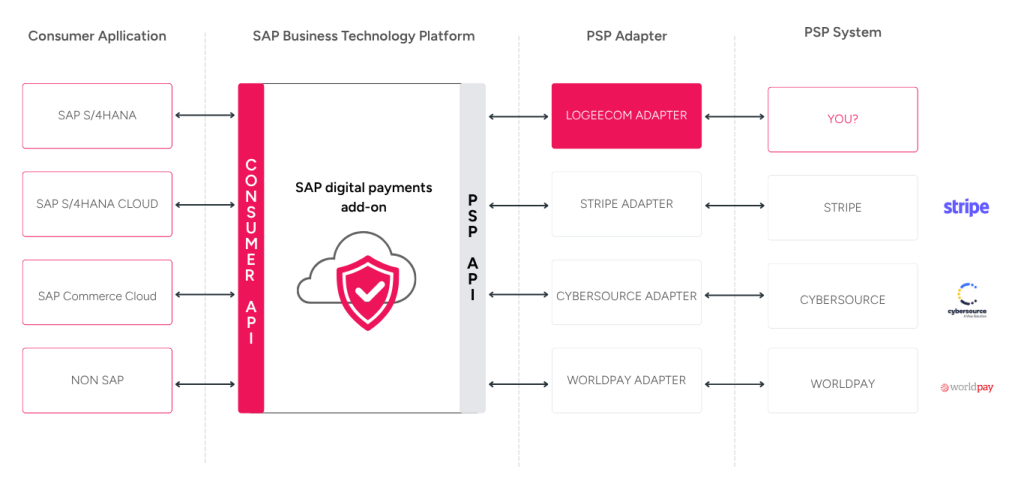The Opportunity Behind SAP Digital Payments Add-On
What is SAP Digital Payments Add-On (DPA)?
SAP Digital Payments Add-On (DPA) is a middleware solution that standardizes how payments are processed across SAP and non-SAP systems. It acts as an integration layer between SAP business applications and Payment Service Providers (PSPs), abstracting away payment complexity for SAP customers while offering PSPs a structured path to enterprise integration.
Key Role of DPA
DPA’s primary function is to provide a centralized and secure interface for digital payments. Instead of building one-off payment integrations across SAP products (like S/4HANA, Commerce Cloud, or Subscription Billing), customers integrate once with DPA—which in turn connects to certified PSP adapters. For PSPs, this means a single adapter opens the door to multiple enterprise scenarios.
Core Components and Architecture
DPA is built on SAP Business Technology Platform (BTP). It works by:
- Exposing a standardized API to SAP business and non-SAP consumer applications
- Communicating with PSPs through certified adapters that handle protocol translation, tokenization, and payment method logic
- Supporting a range of use cases from invoice payments and order-to-cash, to recurring payments and subscription billing
The PSP’s responsibility is to build an adapter that conforms to SAP’s API specification. Once certified, this adapter becomes a reusable asset across SAP customers.
Supported SAP Applications
DPA is natively compatible with several major SAP products:
- SAP S/4HANA & S/4HANA Cloud
For core ERP transactions such as sales orders, billing, and accounts receivable - SAP Commerce Cloud
Enables seamless e-commerce payment flows - SAP Subscription Billing
Handles recurring payment scenarios for SaaS or usage-based billing models
In addition to SAP-native environments, DPA can be used in non-SAP applications such as external webshops, CRM systems, and invoicing portals, provided they route payment requests through the DPA interface.
Security & Compliance
SAP DPA is PCI DSS-aligned, relying on tokenization and encrypted APIs to handle sensitive payment data securely. This design reduces compliance overhead for both the merchant and PSP.
Key security features:
- Payment card tokenization and abstraction
- Encrypted API communication (TLS)
- Centralized access control managed via SAP BTP
Pre-Integrated PSPs vs. Custom Adapters
SAP offers pre-configured support for select PSPs like Stripe, PayPal, Cybersource, and Worldpay. These integrations can be activated with minimal development effort. However, for other PSPs, a custom adapter must be built and certified.
This creates a clear opportunity for PSPs not yet represented in SAP’s ecosystem: by investing in a certified adapter, they gain access to a ready-made enterprise channel with standardized integration logic already in place.
Why Should You Seriously Consider Building an SAP DPA Integration?
For Payment Service Providers, integrating with SAP DPA isn’t just a technical project—it’s a strategic move. Here’s why:
Access to Enterprise Buyers
SAP’s customer base includes over 400,000 organizations globally, from large enterprises to mid-sized companies. Many of them are already using or migrating to SAP’s cloud solutions. A certified DPA adapter gives PSPs access to this market with a plug-and-play integration point.
Alignment with Enterprise Procurement Standards
Enterprises prefer solutions that are certified, standardized, and seamlessly integrated with their existing ERP infrastructure. By completing the DPA certification process, your PSP gains visibility and credibility within this environment.
Faster Go-to-Market with Reusable Components
One certified adapter opens access to multiple SAP products and use cases. Whether the customer is processing one-time payments in SAP Commerce Cloud or managing subscriptions in SAP Subscription Billing, your adapter is the connection point.
Future-Proofing Your Offering
SAP is actively evolving its ecosystem toward modularity, cloud readiness, and B2B flexibility. Integrating now positions your services for growth alongside SAP’s transformation agenda.
Built-In Security and Compliance
With SAP DPA managing tokenization, encryption, and PCI DSS compliance at the integration layer, PSPs can focus on their value-added services without duplicating effort on compliance controls.

The Road to a Solid Integration
Integrating with SAP DPA follows a well-defined process, which includes development, testing, and certification:
Step #1: Understand the SAP DPA API
SAP provides extensive documentation and a standardized API model. Your development team will use this to ensure compatibility.
Step #2: Build the Adapter
The adapter acts as a translation layer between SAP DPA and your PSP’s proprietary platform. It must handle message formats, authorization flows, and responses.
Step #3: Ensure Middleware Compatibility
In some scenarios, middleware is used to manage orchestration, monitoring, or hybrid connections. It must be aligned with SAP’s integration principles.
Step #4: Certification
SAP offers a formal certification process to validate the integration. Certification is required for production use and gives you visibility in SAP solution directories.
Step #5: Support and Evolution
Post-certification, your adapter can be maintained and updated as SAP releases new features or products that rely on DPA. This can be a competitive differentiator.
How Can Logeecom Help?
At Logeecom, we specialize in helping PSPs build enterprise-grade integrations with SAP technologies. If you’re looking to develop a certified SAP DPA adapter, we can:
- Design the adapter architecture based on your existing platform and SAP DPA requirements
- Handle end-to-end development, including secure communication, error handling, and performance tuning
- Support SAP certification, including test case coverage and documentation
- Advise on middleware strategies and hybrid SAP environments
- Enable go-to-market readiness, including integration demos and documentation support for enterprise sales
We work closely with both SAP and payment providers to ensure high-quality, future-proof integrations. Whether you want to tap into SAP’s enterprise ecosystem or expand your product’s reach, we can help you make it happen.
Let’s talk about how to get started.